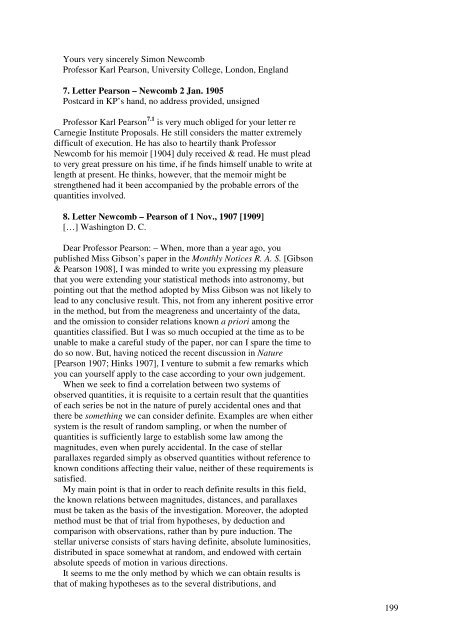1 Ð. Ð. Шейнин СÑаÑÑи по иÑÑоÑии ÑеоÑии ... - Sheynin, Oscar
1 Ð. Ð. Шейнин СÑаÑÑи по иÑÑоÑии ÑеоÑии ... - Sheynin, Oscar
1 Ð. Ð. Шейнин СÑаÑÑи по иÑÑоÑии ÑеоÑии ... - Sheynin, Oscar
You also want an ePaper? Increase the reach of your titles
YUMPU automatically turns print PDFs into web optimized ePapers that Google loves.
Yours very sincerely Simon Newcomb<br />
Professor Karl Pearson, University College, London, England<br />
7. Letter Pearson – Newcomb 2 Jan. 1905<br />
Postcard in KP’s hand, no address provided, unsigned<br />
Professor Karl Pearson 7.1 is very much obliged for your letter re<br />
Carnegie Institute Proposals. He still considers the matter extremely<br />
difficult of execution. He has also to heartily thank Professor<br />
Newcomb for his memoir [1904] duly received & read. He must plead<br />
to very great pressure on his time, if he finds himself unable to write at<br />
length at present. He thinks, however, that the memoir might be<br />
strengthened had it been accompanied by the probable errors of the<br />
quantities involved.<br />
8. Letter Newcomb – Pearson of 1 Nov., 1907 [1909]<br />
[…] Washington D. C.<br />
Dear Professor Pearson: – When, more than a year ago, you<br />
published Miss Gibson’s paper in the Monthly Notices R. A. S. [Gibson<br />
& Pearson 1908], I was minded to write you expressing my pleasure<br />
that you were extending your statistical methods into astronomy, but<br />
pointing out that the method adopted by Miss Gibson was not likely to<br />
lead to any conclusive result. This, not from any inherent positive error<br />
in the method, but from the meagreness and uncertainty of the data,<br />
and the omission to consider relations known a priori among the<br />
quantities classified. But I was so much occupied at the time as to be<br />
unable to make a careful study of the paper, nor can I spare the time to<br />
do so now. But, having noticed the recent discussion in Nature<br />
[Pearson 1907; Hinks 1907], I venture to submit a few remarks which<br />
you can yourself apply to the case according to your own judgement.<br />
When we seek to find a correlation between two systems of<br />
observed quantities, it is requisite to a certain result that the quantities<br />
of each series be not in the nature of purely accidental ones and that<br />
there be something we can consider definite. Examples are when either<br />
system is the result of random sampling, or when the number of<br />
quantities is sufficiently large to establish some law among the<br />
magnitudes, even when purely accidental. In the case of stellar<br />
parallaxes regarded simply as observed quantities without reference to<br />
known conditions affecting their value, neither of these requirements is<br />
satisfied.<br />
My main point is that in order to reach definite results in this field,<br />
the known relations between magnitudes, distances, and parallaxes<br />
must be taken as the basis of the investigation. Moreover, the adopted<br />
method must be that of trial from hypotheses, by deduction and<br />
comparison with observations, rather than by pure induction. The<br />
stellar universe consists of stars having definite, absolute luminosities,<br />
distributed in space somewhat at random, and endowed with certain<br />
absolute speeds of motion in various directions.<br />
It seems to me the only method by which we can obtain results is<br />
that of making hypotheses as to the several distributions, and<br />
199









